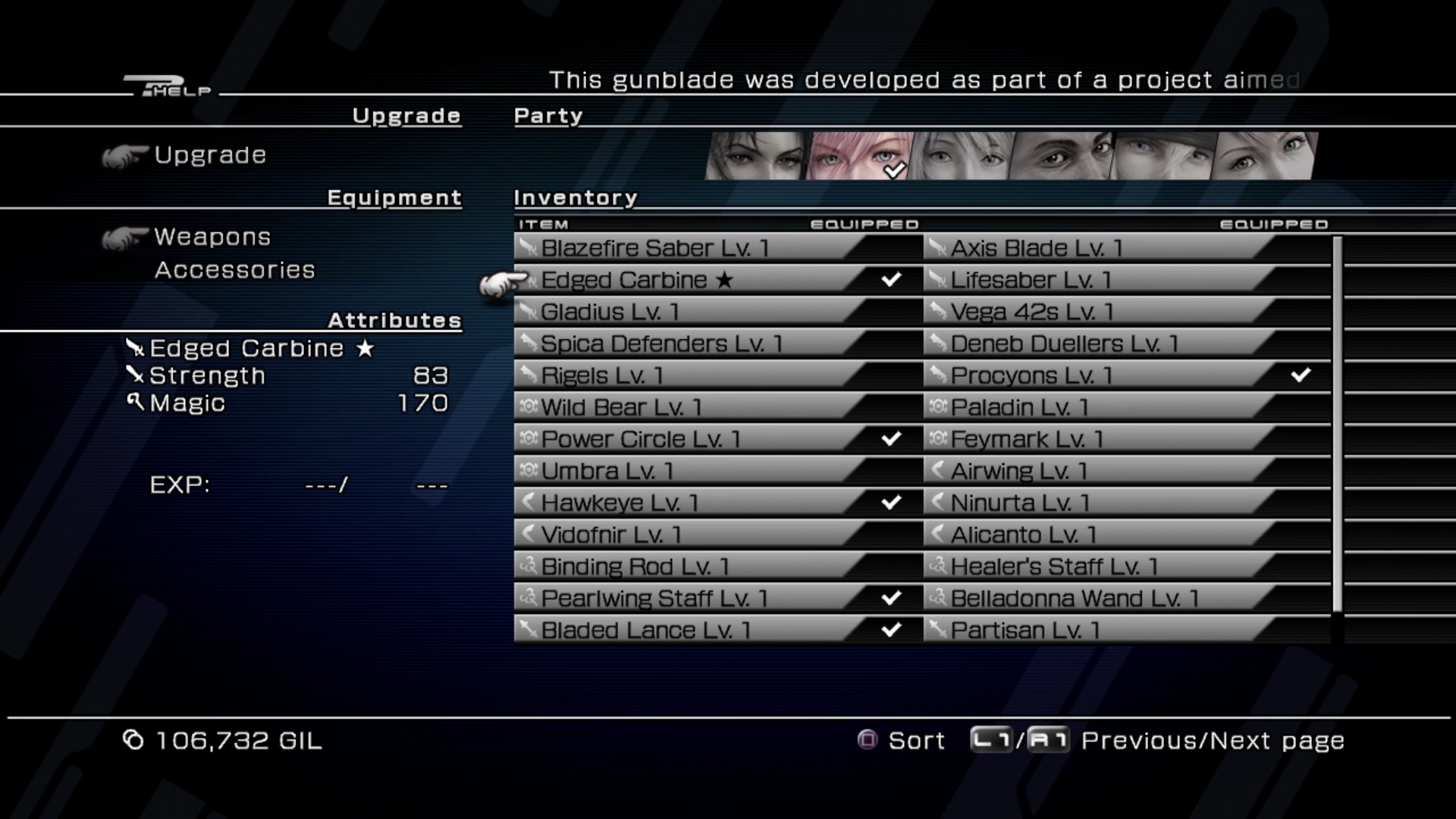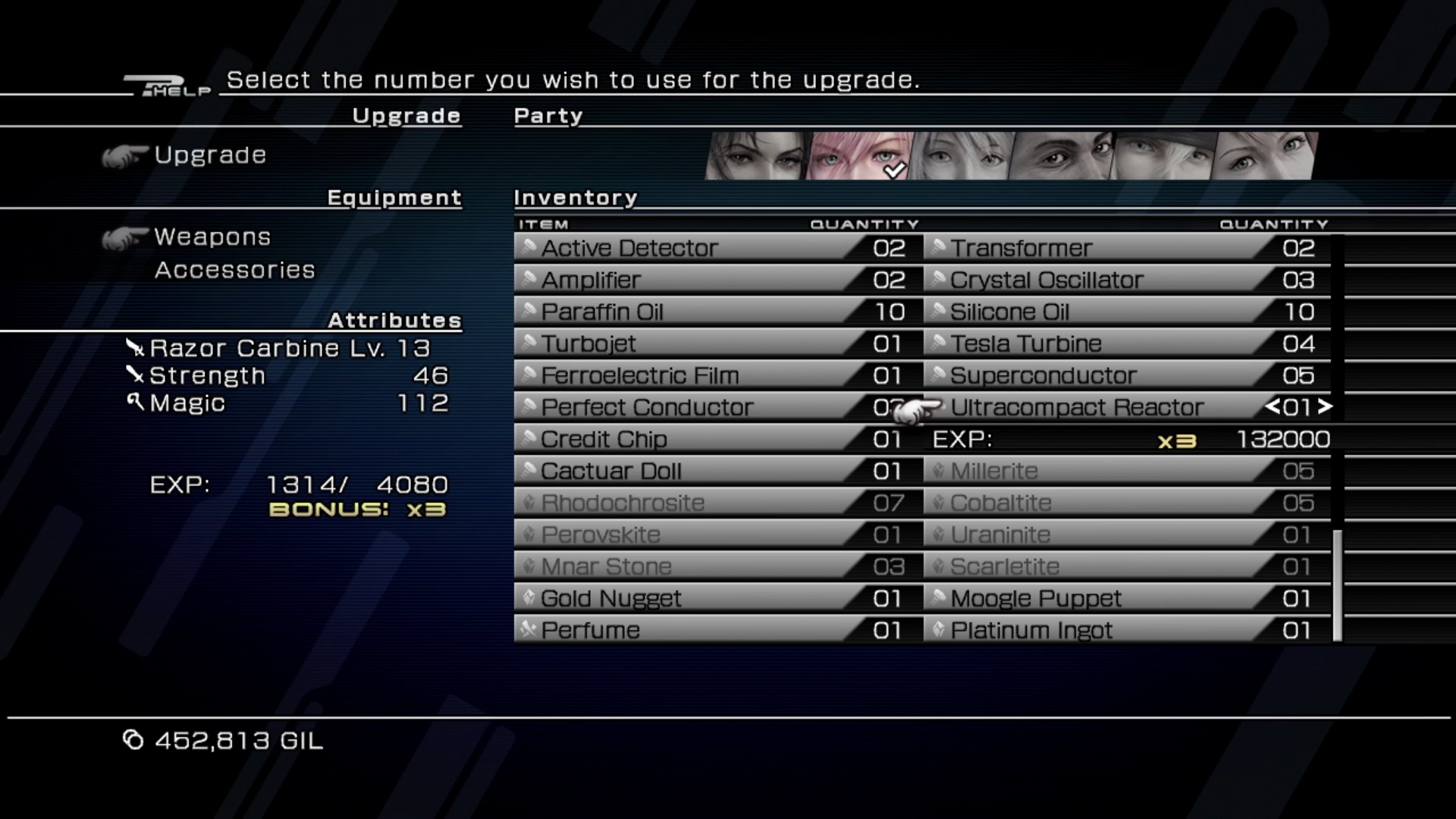You can begin upgrading your equipment after you defeat Dreadnaught during Chapter 4 and receive the ![]() Omni-kit key item. This item allows you to access the “Upgrade” menu option when you open up any of the
Omni-kit key item. This item allows you to access the “Upgrade” menu option when you open up any of the ![]() Save Station throughout the game.
Save Station throughout the game.
That said, it is generally recommended that you hold off on upgrading your weapons and accessories until you reach Chapter 11. As noted in the walkthrough, this is for two main reasons:
- The components you receive in the early areas of the game provide limited value when it comes to upgrading your equipment.
- The content in the early stages of the game, including all of Chapter 5 through Chapter 10, is fairly easy to handle and it certainly doesn’t require you to spend time upgrading your equipment.
The in-game tutorial provides a brief explanation on how to upgrade your equipment, but let’s spend a bit more time so we can go through a more thorough explanation of how the upgrading process works.
Equipment Levels
Each piece of equipment you have, including all of your weapons and accessories, will come at a starting level which is typically level 1 (“Lv. 1”). You can use various components in your inventory to upgrade your equipment, providing them with experience points (EXP), which will increase the level of that equipment. Each level that a piece of equipment gains will potentially increase its stats or its effects and attributes.
Equipment will generally start at level 1 and will increase to its maximum level at which point it will show a next to its name in the inventory screen as shown below:

After reaching its maximum level, identified by the , some equipment can be transformed using a catalyst into a brand-new higher level and more powerful item. This new item will have a new level (“Lv. X”) and can be upgraded again up to its maximum level ().
Some equipment, including all weapons, are capable of transforming twice, at which point they reach their ultimate highest level form.
Components
Components are the items that you have been picking up as spoils at the end of battle as you progress through the game. There are just four different types of components to be aware of:
| Icon | Type | Description |
|---|---|---|
| Organic | These components provide a small amount of EXP but increase the Bonus Multiplier. | |
| Electronic | These components provide a large amount of EXP but reduce the Bonus Multiplier. | |
| Premium | These components have the same icons as Mechanical Components but barely provide any EXP. Their description includes the phrase “Can be sold for a premium.” which is how these components should be used. Sell them at any of the shops for a high amount of gil. | |
| Catalysts | These components are rare and are used to upgrade an item after it has reached its maximum level (). |
EXP and Bonus Multipliers
This is where the math and complexity of the upgrade system can sometimes throw off new players, but the process is actually very simple. Mechanical Components provide the most EXP, but in order to get the best value out of them, you’ll want to use Organic Components on equipment first, which will increase the Bonus Multiplier. This will increase the amount of EXP gained from Mechanical Components by up to 3.00x their original value! (an additional 200%)

EXP and Bonus Multipliers (the Detailed Version)
The process of upgrading your equipment doesn’t require you to know all the underlying details because there are a few select Organic and Mechanical Components that you can use that offer the most efficient means of adding levels to them. This section is skippable unless you want to know the inner workings.
The Bonus Multiplier that the Organic Components add are listed as “Bonus Points” in the Components section of the guide. Depending on how many Bonus Points a weapon or accessory has, using either Organic Components (to increase the Bonus Points) or Mechanical Components (which will reduce the Bonus Points), will change the EXP Bonus according to the chart below:
| EXP Bonus vs. Points | |
|---|---|
| EXP Bonus | Bonus Points |
| 1.00x | 0 to 50 |
| 1.25x | 51 to 100 |
| 1.50x | 101 to 200 |
| 1.75x | 201 to 250 |
| 2.00x | 251 to 500 |
| 3.00x | 501 or more |
So, for example, let’s look at two Components that you will likely be using regularly as part of the equipment upgrade process if you plan to upgrade a bunch of your equipment for the Treasure Hunter Achievement/Trophy…
If a weapon currently has 0 EXP Bonus, which is what they all begin with, and you use a ![]() Sturdy Bone on it, the weapon will gain a small amount of EXP, but it will gain +14 Bonus Points. If you use 10 of these Organic Components on your equipment it will gain a total of 140 Bonus Points which will give the EXP gained from the next Component you use on it an EXP Bonus of 1.75x the EXP.
Sturdy Bone on it, the weapon will gain a small amount of EXP, but it will gain +14 Bonus Points. If you use 10 of these Organic Components on your equipment it will gain a total of 140 Bonus Points which will give the EXP gained from the next Component you use on it an EXP Bonus of 1.75x the EXP.
Mechanical Components have the opposite effect. While they provide a high amount of EXP, they will provide negative Bonus Points, slowly reducing the EXP Bonus multiplier back towards 0 the more they are used.
So this must mean that some Organic Components provide a really high EXP Bonus compared to what they cost and there must be Mechanical Components that offer very strong returns on the amount of EXP they provide, right?
Upgrading Strategy
The answer to the question asked in the paragraph above is: yes! Despite all the Organic Components and Mechanical Components that you receive as spoils as you proceed through the game, there is a very small list of Components that provide the best return for value (i.e. gil spent) and these Components can be purchased from the shops once you reach the later chapters of the game (this is why it’s often recommended that you hold off on upgrading until later!)
When comparing the gil cost across all the available Organic Components, the following three Components offer the best yield for a very low amount of gil:
All three of these items can be purchased in the ![]() Creature Comforts store for 80 gil and they each provide +14 Bonus Points to the EXP Multiplier. This means that you’ll only need to purchase and use 36 of them to reach the maximum EXP Bonus value of 3.00x (costing only 2,880 gil).
Creature Comforts store for 80 gil and they each provide +14 Bonus Points to the EXP Multiplier. This means that you’ll only need to purchase and use 36 of them to reach the maximum EXP Bonus value of 3.00x (costing only 2,880 gil).
Unfortunately, the Mechanical Components are a bit more expensive. The best two Mechanical Components available can be purchased in the ![]() R&D Depot and they are:
R&D Depot and they are:
 Particle Accelerator at 10,000 gil which provides 4,800 EXP
Particle Accelerator at 10,000 gil which provides 4,800 EXP Ultracompact Reactor at 50,000 gil which provides 40,000 EXP
Ultracompact Reactor at 50,000 gil which provides 40,000 EXP
Now, obviously, the Ultracompact Reactor is the better of these two items, but it is very expensive, and you run the risk when using it of giving more EXP points to the equipment you’re upgrading then it requires. If you go over this limit, you’re just wasting EXP and gil, so in some cases it makes sense to utilize a Particle Accelerator instead.
For completing the upgrades for the Achievement/Trophy you won’t need to provide as much experience to the items. Instead of these expensive components, you can purchase a ![]() Superconductor which will provide 200 EXP baseline.
Superconductor which will provide 200 EXP baseline.

Variable EXP
Planning out how much EXP each piece of equipment needs to reach its maximum level can be a bit of a challenge. All items come with a preset invisible “Ranking” which can’t be seen within the game, but which is listed in the equipment sections of this guide, but without busting out the calculator and running the numbers every time, it’s either extremely time-consuming or a bit of a guessing game.
You will generally want to focus on weapons first and foremost though, so to give you a general idea of how much EXP is required to upgrade each weapon, use the following guidelines:
- From Lv. 1 to the first typically requires around 50,000 EXP (then the weapon is upgraded to its second form)
- For an upgraded weapon, leveling from Lv. 1 to the second typically requires around 500,000 EXP (and then the weapon is upgraded into an Ultimate Weapon using a
 Trapezohedron)
Trapezohedron) - For an ultimate weapon, leveling from Lv. 1 to the third and final typically requires around 1,500,000 EXP
The more you can reduce the excess EXP you spend upgrading equipment that has already reached its highest level, the more gil you can save, and the easier it will be to pursue the Treasure Hunter Achievement/Trophy if that is your goal.
Which Weapons are the Best to Upgrade?
Speaking of upgrading weapons, each of your characters will obtain a number of different weapons as you progress through the game, and they can all be upgraded many times, which will cost you a lot of gil. So which weapons should you focus on? Which weapons are considered each character’s best weapons (since they can all be upgraded into an “Ultimate Weapon”)?
Check out the Best Weapons section for more information:
Best Weapons
Tips and Tricks

A guide on which weapons perform best for each character in each of their roles.

